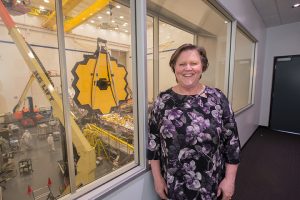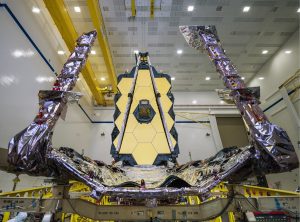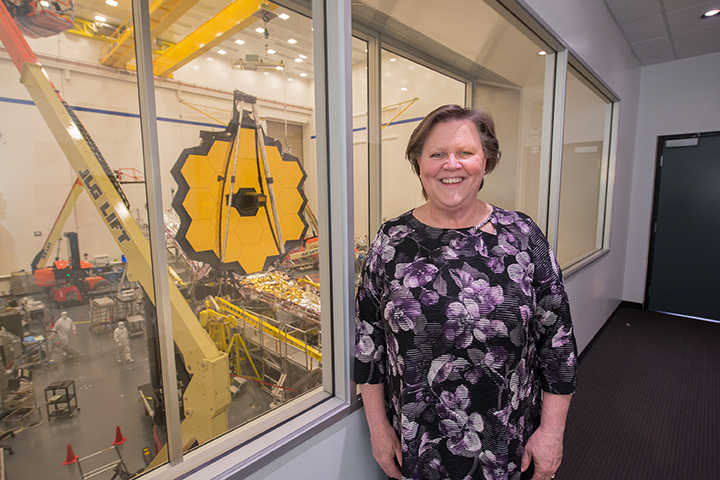Valparaiso University Alumna Reaches for the Stars

On Christmas Day of 2021, at Arianespace’s ELA-3 launch complex at Europe’s Spaceport in French Guiana, an Ariane 5 launch vehicle started its journey toward space. Aboard the rocket was NASA’s James Webb Space Telescope (Webb), the largest, most complex, and most powerful space telescope ever built and the culmination of over 20 years of effort by an international coalition of scientists and engineers, including Valparaiso University alumna Jennifer Love-Pruitt ’81, Northrop Grumman’s electrical vehicle engineering lead.

Jennifer watched from the control room as a project encompassing almost a decade of her career finally, and quite literally, took off.
“It was a lot of elation mixed with panic,” Jennifer says. “There was a knot in my stomach.”
More than 40 years prior to that monumental day, Jennifer was a high school student visiting an older friend attending Valparaiso University. A chance visit to the Gellersen Engineering and Mathematics Center cemented her future as an electrical engineering major at the University.

“I ran into a professor who saw that I wasn’t one of their regular students,” Jennifer says. “He probably spent an hour showing me the classrooms, the labs, and the school. That friendliness, that environment, was what I wanted to be a part of.”
The professors and community at Valpo would continue to play a major role in helping Jennifer not only find where to take her skills, but also pursue the life-changing experiences she wanted to be part of her Valpo experience. Jennifer wanted to study abroad in Reutlingen, Germany, a program that, at the time, was typically infeasible for someone on her degree track. Through determination and cooperation with faculty, however, she was able to participate.
“I think Professor Edgar Luecke realized how stubborn I was when I said I didn’t care if it took me five years to get my degree,” Jennifer says.
With Professor Luecke’s help, Jennifer was assigned an independent study course while she was abroad. He also worked with her when she was unable to finish the assignment, and when she considered dropping out of engineering altogether, helping her work over the summer and through the remainder of her academic career to keep her on track.
“He was the reason I stayed in engineering, and he’s the reason I got through in four years,” Jennifer says. “He was my mentor. He did a lot for me.”
Valparaiso University also gave Jennifer the opportunity to do good in the world with her skills as a student. For her senior project with Professor Rodney Bohlmann, Jennifer completed the design and microprocessor programming for B.L.E.S.S. (Back-Lit Electronic Symbol Scanner), a device to help a nonverbal child communicate with those around him.
“It was amazing to see that what I could build had such an impact on someone’s life,” Jennifer says. “The little boy was able to communicate in a way he couldn’t before. That was really emotional.” Jennifer was a member of the engineering honor society Tau Beta Pi, the Institute of Electrical and Electronics Engineers (IEEE), and was the pianist for several musical productions during her time at Valpo.
“I took piano lessons for fun, just to do something outside of engineering,” Jennifer says. “It was fun, and non-technical.”
While Jennifer had gotten the opportunity to nourish and develop her skill and passion for electrical engineering, she was still unsure of what to do with her degree. That was until TRW Inc., a legacy Northrop Grumman company headquartered in California, came to the University to conduct interviews with College of Engineering students.
“It was really the first time I had even thought about aerospace engineering,” Jennifer says.
Those chance meetings and determination to explore her opportunities led Jennifer to Webb’s control room, carefully monitoring the successful launch of her biggest project to date. Despite the successful takeoff, leaving the Earth was only the first step in a long, anxious road to deploying the Observatory and putting the telescope where it needed to go: one million miles away, at a point known as Lagrange Point 2 (or L2), a position that will keep it in relative position with the Earth as both orbit the sun.
NASA’s Webb Telescope, built in partnership with Northrop Grumman and done in collaboration with various international agencies, has presented Jennifer and the Webb team with a host of novel problems to solve.
“Webb as a whole is such a complex system,” Jennifer says. “The team broke new records with the size, which informed our approach and design. To fit it into the rocket, the sunshield and mirrors had to fold up like origami and unfold once in space. I also love the quote from one of our NASA leads who said we ‘had to build it perfectly wrong’ at one-g and ambient temperatures so that it was perfectly right in zero-g at cryogenic temperatures.”
Jennifer and her team were responsible for all the electrical subsystems in the spacecraft bus, which included systems that would keep the antennas pointed at the Earth for communication, store and transmit the science data, perform attitude control, provide power conditioning and distribution, and manage all of the deployments.
The deployment electronics controlled 13 different motor driven deployments and fired over 170 non-explosive actuators (NEAs) that had to be executed individually over a two-week period after launch.
“Those represented 178 single-point failures,” Jennifer says. “If any one of those didn’t go right, we would have been in trouble. It was just a huge celebration at the end of those 14 days when all of the deployments were successfully completed.”
The Webb Telescope is now orbiting at L2, and while months of mirror alignments and instrument commissioning are required before the telescope is ready to conduct research, Jennifer believes that all the effort and anxiety will be well worth the trouble.
“As human beings, we’re curious and want to explore,” Jennifer says. “We’ve taken Hubble to the limit. If you want to look further, you have to go infrared. If you want to study exoplanets, which are planets orbiting other stars, you will be able to study their atmosphere with Webb.”
For today’s Valparaiso University students looking to go into aerospace engineering, Jennifer says a well-rounded skill set will go a long way, and that Valparaiso University was instrumental in giving her the skills that put her where she is today.
“I walked out with a really solid technical foundation,” Jennifer says. “The liberal arts classes then took that and made me more well-rounded. That mix let me walk away with the full picture.”
Jennifer also believes that ethics and integrity are key to the pursuit of success in any career path.
“When I say ethics and integrity, I basically mean the Valpo honor code translated to the corporate environment,” Jennifer says. “Doing the right thing and following the rules. It’s about being up front and honest. You don’t fudge anything; you don’t hide anything. Integrity is being honest in all of your work. It’s required to ensure the success of projects like Webb.”
Jennifer has remained dedicated to Valparaiso University even after graduation, and she is a member of the Valpo Guild. The connections she made with friends and professors have kept her coming back to campus whenever the opportunity arises.
“I made lifelong friends,” Jennifer says. “The professors are there to teach, they are there because that is their focus. I love the environment, and I love the Chapel.”
The entire 29-day period between Webb’s launch and arrival at L2 is chronicled in the video “29 Days on the Edge,” which can be viewed here. The progress and location of Webb can be monitored remotely at James Webb Space Telescope (nasa.gov).
